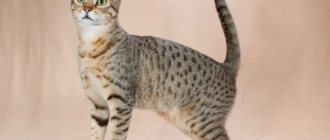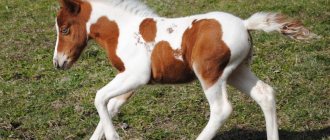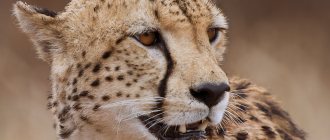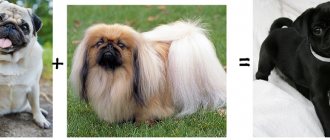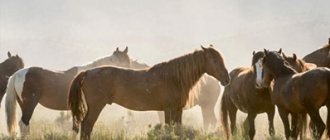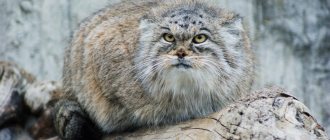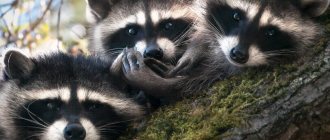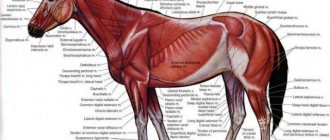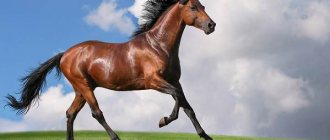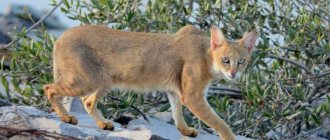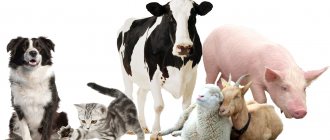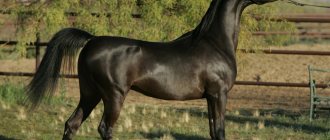According to some reports, there are over 100 million horses . The vast majority of them are representatives of numerous breeds of domestic horses. There are practically no wild animals left. It took tens of millions of years for a small fox-like creature that lived in prehistoric forests to turn into a beautiful creature of nature, striking in its harmonious forms and proportions.
During a long evolutionary process, types of animals were formed, each of which contributed its own “building block” to the modern phenotype of the domestic horse. Read about how this happened in this article.
Change and natural selection
The evolutionary history of the horse genus begins about 60-70 million years ago . It is possible to talk about the fauna and flora of prehistoric times only based on facts and findings studied by paleontology. Thanks to the Russian scientist Kovalevsky, who was attracted by fossil forms of equids, the main stages of development of the horse genus are well defined. The scientist proved that the course of the process, its duration, and intensity were actively influenced by changes in the external living conditions of animals.
The history of the appearance and development of odd-toed ungulates of the horse genus most clearly proves the correctness of Darwin's theory, based on the principle of variability, heredity and natural selection. Thanks to these laws, from generation to generation more and more new groups and species of animals arose, different from their ancestors. The constantly changing environment required animals to adapt to new living conditions. Adaptability is the key to the survival of a species. Throughout the evolution of equids, we see constant changes in jaws and limbs. From species to species, the chewing apparatus became more powerful, the limbs lengthened, and a change occurred in the method of movement. What caused such transformations? Let's talk about this in more detail...
Anchiterium
Along with many other species, Anchitheria appeared in North America, and then in Europe. These animals became even larger than their ancestors and reached the size of a modern pony. The middle finger has become even more pronounced than the side fingers.
During this period, cooling began on the planet, which led to an increase in the area of steppes and the retreat of forests. These climate changes began to affect the ancient horses, which in turn had to adapt in order to survive.
Anchiterium looked like a small horse and reached the size of modern ponies.
The appearance of the anchytherium began to change: the legs became longer, and the front part of the skull lengthened.
Eohippus and Hyracotherium
The ancient ancestors of the horse appeared in the Eocene era (about 60 million years ago). One of them was Eohippus, which lived in the tropical forests of North America. Its relative, Chiracotherium, has chosen the lands of what is now Western Europe. It would be impossible to recognize in this freak (no more than half a meter tall) with a convex back, a small head on a short neck - future powerful heavy trucks, graceful Akhal-Teke horses, and Arabian horses as fast as the wind.
Eohippus
The ancient creature's appearance more closely resembled a dog or sheep. The paleontological remains of this animal were discovered in the 60s of the 19th century. Interestingly, the name “Eohippus” is translated as “First Horse”. Soft fruits and juicy leaves served as food for Eohippus. Therefore, his teeth were not at all like the teeth of a modern horse. They had a low crown, because they were adapted for pinching and grinding delicate vegetation. When walking, the animal rested on the four toes of its thin front paws. The hind limbs had three toes.
Remains of an ancient creature
Mule
A hybrid of a donkey and a mare is called a mule, and a hybrid of a donkey and a stallion is called a hinny. Both are sterile, so in order to get a new individual, you have to re-attract horses and donkeys. In appearance, the newly minted hard workers are more like their mother, but they inherit their character from their father. The mule was first bred 4 thousand years ago in the Middle East. He was the most useful of working animals and was valued more than horses. Even the rulers rode it. Mules are smart, resilient, strong and much more economical than horses. They cope with work in difficult conditions. Mules have a strong body and can reach a height of 155 cm. In both world wars, mules were widely used to transport ammunition, and the Indian Army still uses mules for various transportation purposes.
Evolution continues
The species Eohippus and Chiracotherium existed for about two tens of millions of years, from the Eocene to the Oligocene. They settled over vast territories of America and Eurasia. Where the Bering Strait is now located, in ancient times the two continents were connected by a narrow isthmus. Hyracotherium and Eohippus traveled along this “bridge.” In the end, they gave way under the sun of the prehistoric planet to larger animals, in which all limbs were equipped with three fingers. These were: mesohippus, parahippus, anchytherium. The Miocene era has arrived. It became much colder. Instead of swampy impenetrable jungles, broad-leaved forests grew, and endless steppes and meadows spread out.
In order to survive, all branches of the horse family had to change their diet. Juicy fruits and shoots are a thing of the past. They were replaced by dry and hard grass. This led to changes in the chewing apparatus. Enamel ridge-shaped irregularities appeared on the surface of the mesohippus teeth, and the height of the crowns increased. More advanced jaws helped chew hard food more thoroughly. The soft, swampy soil was replaced by solid ground. This became the reason for the improvement of limbs in new species of ancient Equidae.
From the remains of mesochippus we see that they had three toes on all four legs. But when walking, they relied on the more developed middle finger, which ends in a hoof. The animal itself became significantly larger than its predecessors. Its height had already reached 120 cm. Another species of ancient equine that lived at about the same time was Anchitheria. They made a journey from America to Asia about 24 million years ago. But that didn't help them. Anchitheria, which was as tall as a pony, died out without leaving any heirs.
Zebras
These striped animals live in southern Africa. There were once many different species of zebra, but today only three survive.
- Gravy's zebra, the largest of the zebras, covered with the narrowest and therefore most numerous stripes, is considered by many to be the most beautiful. They live in the north; today their number does not exceed 7 thousand.
- The mountain zebra, which inhabits the southern highlands, is also in danger of becoming extinct.
- The most numerous species is the savanna zebra, which lives in huge herds in the east.
- There are seven subspecies that differ in their stripe patterns. The most common is the Hartmann's zebra, which has a unique lattice stripe pattern on its rump.
Even zebras of the same subspecies cannot have the same stripe pattern on their body; the pattern on the right and left sides is also different. The stripes provide camouflage, a “dismembering coloration” that blurs the silhouette and confuses predators. Zebras are very hardy and gallop faster than domestic horses; They are almost impossible to domesticate.
One-fingered ancestors
Anchyteriums were replaced by Pliohyppus. vast areas in the Upper Miocene era ( 5 million years It displaced other types of fossil horses. Herds of thousands of hipparions migrated from North America to Asia. Then they mastered the steppe expanses of Europe. But the hipparions failed to get to Africa, Australia and South America; the seas and wide straits prevented them. The descendants of the hipparions, the one-toed pliohyppuses, completely ousted all three-toed animals from the planet. The replacement of some widespread species by others occurred during the Pliocene era (5.0-2.5 million years ago).
The remains of Pliohyppus show that this animal had many of the features of a modern horse. Although the differences are still quite significant. The similarity with current species of horses is noticeable in the structure of the chewing apparatus. The enamel wave-like ridges on the teeth of Pliohyppus are more pronounced than those of its fossil predecessors. The enamel layer is thicker than, for example, that of the same hipparion. Scientists believe that the ancestors of the modern genus Equus (horse) were Pliohyppus and its descendant, Plesippus. Winning advantage.
Forced to live on the prairies, the three-toed ancestors of modern horses could no longer use their feet for support. They found themselves defenseless against ancient predators. Among their enemies were the ancestors of today's wolves. It was urgently necessary to change the way of movement and learn to run. Pleohippus become single-toed. Of course, this did not happen in one day. But already in their earlier predecessors we see a gradual modification of the limbs. Development of one finger and atrophy of the others. At pleohippus this process comes to an end. His feet already have well-developed middle toes, protected from blows by a keratinized nail (hoof). Single-toedness became a winning advantage of pliohippus in the fight against other equine species for survival. Thanks to the support of one finger, the animals rushed faster than their enemies.
Ancient pliohippus Scientists find remains of pliohippus in many parts of the world: Africa, North America, Europe. Thanks to these finds, its appearance was restored. It has an elongated skull with a narrower forehead than that of modern horses. Small teeth and thin legs with strong hooves. With the help of these bone plates, pliohyppus plowed through the snow, extracting grass. Geological processes have once again changed the face of the Earth. Where the seas used to stretch, land was exposed, and isthmuses connected the continents.
Pliohyppus had no obstacles left to conquer all parts of the world. They populated almost every corner of the Earth. They left a rich offspring, from which later descended those whom zoologists now unite in the equine family: zebras, wild donkeys and half-donkeys, wild Przewalski's horses and domestic horses of all breeds. And suddenly all the pliohyppus, as well as the plyosippus that descended from them, disappeared. What happened?
Donkeys
There are two groups of donkeys: Asian and African. Asian half-donkeys are a cross between a donkey and a horse. With their light body, they more closely resemble a horse, but their voice is more like the cries of a donkey than the neighing of a horse. Today, many subspecies of half-donkeys live in Asia and the Middle East: the Mongolian kulan, fast and hardy, the Tibetan kiang, adapted to high-mountain living conditions, the Indian onager, jigetai, khur. The ancestor of the domestic donkey is the Nubian wild ass, which still lives in the bleak, rocky deserts of Africa.
It is perfectly adapted to life in a hot, dry climate. The donkey was domesticated much earlier than the horse. On average, donkeys are about a meter tall, but miniature donkeys from Sicily and India are no more than 60 cm, and in Spain, on the contrary, they are as tall as a small horse. They are extremely strong and resilient for their size and can survive on one bowl of beans a day. Donkeys have a narrow body, a flat back, thin but strong legs, long ears and a short erect mane; Everyone knows the heartbreaking donkey cry “ee-a”. Donkeys come in different colors: from black to savras, there is a black strap running along the back and there is a famous black stripe at the withers, symbolizing the cross he left in memory of the donkey that carried Jesus to execution in Jerusalem.
Colds and troglodytes
Why did all the ancient horses go extinct in North America a million years ago within a short period? This may have been due to the continuous glaciation that the continent underwent. The return of the Equid to their historical homeland occurred only in the 15th century, during the time of the conquistodors. Africa was luckier; its climate changed without sharp fluctuations, so archaic subspecies of the horse genus - zebras and donkeys - were preserved there. In Europe and Asia, two species of then still wild horses were able to survive. They existed until the time when, in addition to all other predators, they had another dangerous and ferocious enemy. Humanoid troglodyte creatures began to hunt the ancient horses. Newly erected on two limbs, not unlike animals, future humans were effective hunters. Arranging a round-up in which the entire tribe participated, they drove the animals into a deep ravine, where they finished them off with stones and spears. After the meat of the ancient horse was eaten, it was painted on the walls of the cave. This happened during the next ice age.
Myohippus
With the gradual increase in open spaces and the extinction of mesohippus, myohippus appeared on Earth around 35-30 million years BC. The rarest mammal immediately formed 2 subspecies - forest and steppe horses. Forest inhabitants migrated to the territory of the North American continent and became the ancestors of the Architeria.
The real horses of those times were the steppe inhabitants. The digital processes of their limbs have become stronger and their teeth have changed greatly. They became an ideal chewing tool, adapted to grinding tough steppe grasses. It was the ability to digest tough and low-nutrient food that turned out to be a real salvation for ancient horses during periods of global cooling. Subspecies that fed on delicate foliage and young shoots of trees became extinct very quickly.
Primitive horses
There have been several critical cold spells in the history of the Earth. Each of them radically changed the flora and fauna. Europe was subject to especially dramatic changes in climate and landscape. The increasingly harsh external environment accelerated the evolutionary process of the animal and plant world. That is why in Europe a subspecies of real horses has developed, which are quite different from their other neighbors in the genus - zebras and donkeys. Primitive horses that lived 10-11 thousand years ago differed little from modern horses. The transformation of the limbs and jaws, their lengthening, caused changes in the proportions of other parts of the body of the Equid.
They grew taller, their heads crowned by a long neck. It has become much more convenient to survey the surroundings, looking for danger. The structure of the brain of Ice Age horses became more and more complex, animals acquired new physiological qualities that helped them survive. But in the end, almost all wild horses were exterminated by primitive hunters. The remaining wild individuals of various species in the Neolithic became the subject of domestication.
Scientists believe that about 10 thousand years ago (the end of the Ice Age), three species of primitive wild horses, differing from each other in habitat, size and physique, became the blood forefathers of modern breeds. The animals that lived in the forests were tall and big-boned. Those who lived in the steppes and on hilly plains had graceful bodies and fast running. The color also depended on the habitat, from brown to yellowish sand.
Mesohippus
Following their evolutionary ancestors, larger mesohippus appeared on Earth. They existed in the final period of the Paleogene. The animals reached a height of more than half a meter and already had 3 fingers on all limbs. The structure of the finger processes has also changed: the middle one has increased significantly in size.
Changes in appearance were directly related to changes in environmental climatic conditions. If the first horses lived under the reliable protection of primeval forests, then their descendants adapted to the open forests of forest-steppe zones. The area of open spaces has increased, as has the number of enemies. Horse ancestors had to learn to run fast and the extra toes gradually atrophied. The digestive system and jaw structure also underwent changes.
From them came the breeds
Zoologists trace the pedigree of today's draft horses back to forest horses . A broad-boned, powerful animal skeleton covered with thick skin and coarse hair. The height reached more than one and a half meters at the withers. Forest horses firmly planted their powerful legs on the ground. Horse bones were discovered in layers of late Paleolithic sites excavated in river valleys from the Western Dvina to the Dnieper and Don. The remains of a forest horse have been found in other places in Europe. For example, in the territory of what is now the Arkhangelsk and Vologda regions of Russia. Researchers discovered on the shores of Lake Ladoga the bones of a very large wild horse that lived about 4 thousand years ago. If desired, in the appearance of massive heavy trucks you can see the features of their distant ancestor, who lived in the coniferous forests of the glacial and post-glacial periods.
The big-headed steppe horse has survived to this day only in zoos. It is known as the Przewalski horse. Named after the Russian traveler who discovered this equine subgenus in the Mongolian steppes in the 19th century. Since Neolithic times, stallions and mares of this species have retained a small but well-developed body, short ears, and a coarse black mane with a “hedgehog” shape. The lower part of her muzzle is decorated with long sideburns. Savrasaya suit is found in various shades. Przewalski’s horse seems to have dark “stockings” stretched up to his knees. These small horses (height 120 - 130 cm) lived in the arid regions of Central Asia from the Stone Age to the 70-80s of the last century. Here the semi-deserts are occupied by wormwood, salt marshes, and dry thorny saxaul bushes grow in the lowlands. In search of food, herds traveled vast waterless distances. Thousands of years of harsh life have developed horses with amazing endurance. There are currently about 2 thousand steppe horses in captivity. They have not been seen in the wild for several decades.
Tarpans are another species whose blood flows through the veins of modern domestic horses. Their numerous herds crushed feather grass in the Don, Volga, Ukrainian and Crimean steppes until the second half of the 19th century. Free wild horses raced across the deserted, unplowed expanses. They were also found in Lithuanian forests, in Belovezhskaya Pushcha. The South Russian tarpan had a short thick neck and gray skin. There was a dark stripe running down the back in the shape of a belt. According to some evidence, the last tarpan died in the 80s of the 19th century. According to others, this happened later, in 1918-19. Zoologists believe that the blood of this tireless horse with a miniature head flows in representatives of many Russian breeds.
Wild tarpans were distinguished by their aggressive temperament, they were careful, easily evaded pursuit, and could run for long hours at high speed. No one has been able to tame adult tarpans. Only when caught as foals, tarpans obeyed humans with difficulty. Wild tarpans were exterminated using firearms. But that is another story…
Parahippus, 24-17 million years ago
In general, Parahippus most closely resembled those modern horses, of which it was the ancestor. Completely new legs and teeth appeared in his “arsenal”. More precisely, they were not so much new as significantly improved. For the first time, this animal began to run not on the entire area of the foot, but precisely on its short, thick toes.
The fact is that in the Miocene there were even fewer forests, but the number of steppes covered with herbaceous plants increased sharply. Accordingly, there were practically no shelters at all, and therefore the ancestors of horses had to speed up even more.
It's worth making a digression here. The history of horses knows several cases of how equids at this time took a different path. We are talking about tapirs. They are also the distant ancestors of horses, who chose to leave with the retreating jungle rather than adapt to the difficult conditions of the steppes.
About horses, fibulas: useless leftovers or great design?
Many evolutionists argue that the fibula bones of the horse's legs (see picture to the right) are vestigial, i.e. useless remnants of their claimed evolutionary past. However, as evolutionary zoologist Scadding noted, “Vestigial organs do not prove evolutionary theory.”21
He draws attention to the anti-scientific nature of this argument. It is in principle impossible to prove that an organ has no function; most likely it could have a function that we do not know about.22 Scadding also reminds us that “as our knowledge has increased, the list of vestigial structures has decreased.” It shows that the hundreds of such organs claimed by 19th-century scientists have been reduced to a few questionable cases.22 Moreover, vestigial organs can at best prove degeneration (i.e. loss of information) rather than evolution.
The fibula bones of the horse in particular serve several important functions. They make the leg and foot bones stronger, which is very important for a galloping horse. These bones are also attachment points for important muscles. And finally, they form a protective recess in which the suspensory ligaments are located - the necessary elastic plate that redistributes the horse’s body weight as it moves.24
Horse breeding in China
At the beginning of the 21st century. China ranks second in the world in the number of horses. Horses in China are small, they are of the Mongolian breed. Their weight is 300-350 kg. They are hardy and unpretentious to feed. The country is taking measures to improve the livestock: Oryol trotters, heavy draft stallions and horses of the Vladimir breed are imported from Russia. Inner Mongolia, Xinjiang Uygur Autonomous Region and Heilongjiang Province specialize in herd horse breeding. Chinese horses are fed mainly with straw, barley, and beans. Used for cultivating land.
Kulan
The kulan is an animal much like a horse. He is handsome and slender, muscular and lean. The only thing that distinguishes him from a horse is his head, which is somewhat large. It is believed that the kulan is the fastest among ungulates. It can reach speeds of up to 65 km/h, and sometimes up to 70 km/h.
The kulan feeds on dry grass in summer and frozen grass in winter.
Read also: Types and types of electrical contacts
He takes this grass out from under the snow. This is a sign of domestic horses. The scientific name for domesticated horses is “cabo,” which is Latin for “dig.”
The kulan defends itself from predators with its hooves and teeth, but more often it flees.
